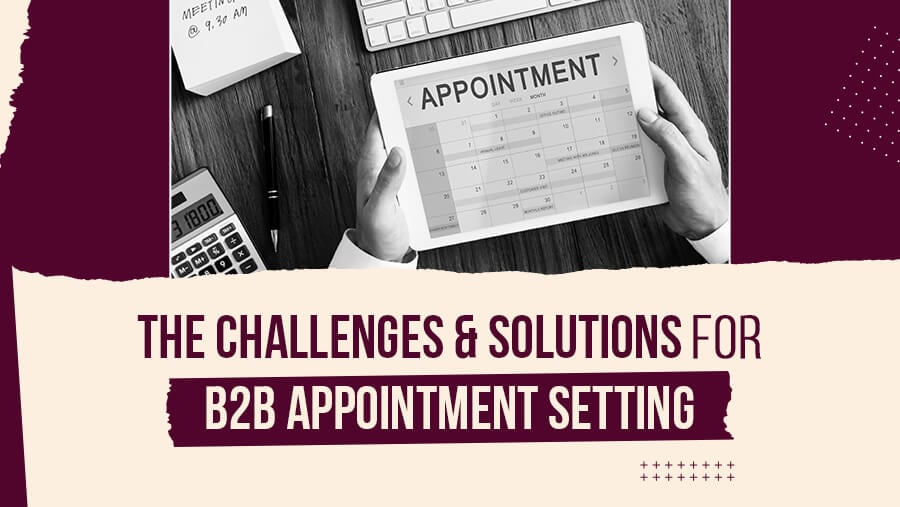
The Challenges and Solutions for B2B Appointment Setting
In today’s competitive B2B landscape, securing meaningful conversations with decision-makers is harder than ever. B2B appointment setting acts as the linchpin of outbound marketing, bridging the gap between lead generation and successful sales. But it’s not without its hurdles.
Companies with effective lead management practices see 50% more sales-ready leads at 33% lower costs (HubSpot). This underscores the critical role appointment setting plays in driving revenue.
This blog will uncover the key challenges that hinder appointment-setting success and provide practical, actionable solutions to help your business connect with high-value prospects.
Why B2B Appointment Setting Is Non-Negotiable
Appointment setting is more than just booking meetings; it’s the foundation of a successful sales pipeline. This process helps identify qualified leads, establish trust, and nurture meaningful relationships with potential clients.
For B2B companies, especially in industries with long sales cycles, effective appointment setting ensures that sales teams focus on high-intent prospects. Yet, without a well-executed strategy, even the best product or service can get lost in the noise of a crowded market.
This guide will help you navigate the common pitfalls and implement solutions that deliver tangible results.
Challenges in B2B Appointment Setting
While the goal is simple—secure a meeting with decision-makers—the challenges are multifaceted. These obstacles can be categorized into operational, strategic, and executional challenges.
A. Operational Challenges
1. Time and Resource Constraints
Appointment setting is a resource-intensive process. Between researching prospects, crafting tailored messages, and coordinating schedules, sales teams often stretch themselves too thin, leaving little room for them to focus on closing deals.
2. Inconsistent Follow-Up
Following up is essential, but it’s often overlooked or deprioritized. Many businesses stop after one or two attempts, missing out on opportunities to nurture leads. According to The Brevet Group, 80% of sales require five follow-ups, yet 44% of salespeople give up after the first attempt.
B. Strategic Challenges
1. Poorly Targeted Leads
Generic outreach wastes time and resources. Without clear criteria for identifying high-value prospects, businesses risk targeting leads who lack the interest, authority, or budget to move forward. In fact, 60% of B2B marketers cite generating high-quality leads as their biggest challenge (Demand Gen Report).
2. Misalignment Between Sales and Marketing
When sales and marketing teams operate in silos, leads often fall through the cracks. Miscommunication about lead quality or unclear handoff processes can derail even the best appointment-setting strategies. Companies with aligned teams achieve 208% more revenue (Marketo).
C. Executional Challenges
1. Difficulty Reaching Decision-Makers
Decision-makers are busy, shielded by gatekeepers, and inundated with outreach attempts. According to Gartner, only 2% of cold calls result in a meeting, illustrating the challenge of cutting through the noise.
2. Lack of Personalization
Generic messages fail to resonate in a market where personalization is expected. Campaign Monitor notes that personalized emails achieve 29% higher open rates and 41% higher click-through rates. Without tailoring your outreach, prospects are likely to ignore your efforts.Practical Solutions for B2B Appointment Setting
Overcoming these challenges requires a combination of strategy, technology, and alignment. Here are actionable solutions to improve your appointment-setting efforts.
1. Enhanced Targeting Through Data-Driven Strategies
Accurate targeting starts with a clear Ideal Customer Profile (ICP). By focusing on the right prospects, you can maximize your chances of securing meaningful conversations.
How to Get It Right:
- Use tools like LinkedIn Sales Navigator, ZoomInfo, and intent-data platforms to identify decision-makers.
- Segment your audience by industry, company size, and role.
- Regularly update your database to avoid wasting time on outdated leads.
2. Personalization at Scale
Prospects respond better to messages that speak directly to their needs and pain points. With the right approach, you can personalize outreach without overwhelming your team.
How to Personalize Effectively:
- Research the prospect’s challenges, recent developments, or company milestones.
- Mention specifics like the prospect’s role or a recent event in their industry.
- Use tools like Outreach.io to create personalized templates efficiently.
Tip: Instead of a generic “Let’s connect,” try “How [Their Company Name] Can Save 20% on Logistics Costs.” It’s specific and value-driven.
3. Multi-Channel Outreach for Maximum Reach
Reaching prospects through multiple channels ensures your message isn’t missed. You can create a comprehensive outreach strategy by combining email, LinkedIn, phone, and SMS.
How to Structure Multi-Channel Outreach:
- Start with an email introducing your value proposition.
- Follow up with a LinkedIn connection request or message.
- Use phone calls to reinforce your value.
- Send SMS reminders closer to the meeting date.
4. Automating Follow-Ups Without Losing the Human Touch
Consistency in follow-ups is critical, but it doesn’t have to be manual. Automation tools can help you maintain regular contact while keeping the message personalized.
- Be Consistent: Automation ensures timely follow-ups without manual effort.
- Add Personalization: Use names, company details, or specific triggers for tailored outreach.
- Segment Leads: Group prospects by industry, company size, or sales stage for relevant messaging.
- Use Smart Timing: Automate follow-ups based on actions like email opens or link clicks.
- Recommended Tools:
- HubSpot: Easy-to-use email sequences and tracking.
- Salesforce: Scalable, customizable workflows.
- Apollo.io: Perfect for personalized outbound campaigns.
5. Leveraging Appointment-Setting Services
Outsourcing appointment setting to a specialized agency can free up your team to focus on closing deals.
Why It Works:
- Agencies like Revnew bring expertise in targeting and outreach.
- They ensure consistent follow-up and a steady pipeline of qualified meetings.
Example: A healthcare SaaS provider partnered with Revnew and saw a 50% increase in appointments in two months.
6. Aligning Sales and Marketing for Seamless Execution
Collaboration between sales and marketing teams is essential for success. When both teams work toward shared goals, the entire appointment-setting process becomes more efficient.
How to Align Teams:
- Define shared KPIs, such as lead-to-appointment conversion rates.
- Use a shared CRM for transparency.
- Hold regular sync meetings to address challenges and share insights.
7. Optimizing Performance with Data
Regularly analyzing your outreach efforts ensures continuous improvement. By tracking key metrics, you can identify bottlenecks and refine your strategy.
Key Metrics to Monitor:
- Contact rate
- Response rate
- Appointment conversion rate
- Cost per appointment
Pro Tip: Use A/B testing to refine subject lines, call scripts, and email templates. For example, test whether a value-driven subject line performs better than a question-based one.
Final Thoughts
While B2B appointment setting has its challenges, it remains a crucial step in building a robust sales pipeline. By overcoming operational inefficiencies, improving lead targeting, and leveraging the right tools and strategies, businesses can ensure a steady flow of high-value meetings. Personalization, team alignment, and consistent follow-up are not just best practices—they are essential to turning prospects into customers.
Don’t let these challenges hold your business back. With the right support and expertise, appointment setting can become a predictable, scalable process that drives tangible growth.

.jpg?width=60&name=deepti%20(2).jpg)



